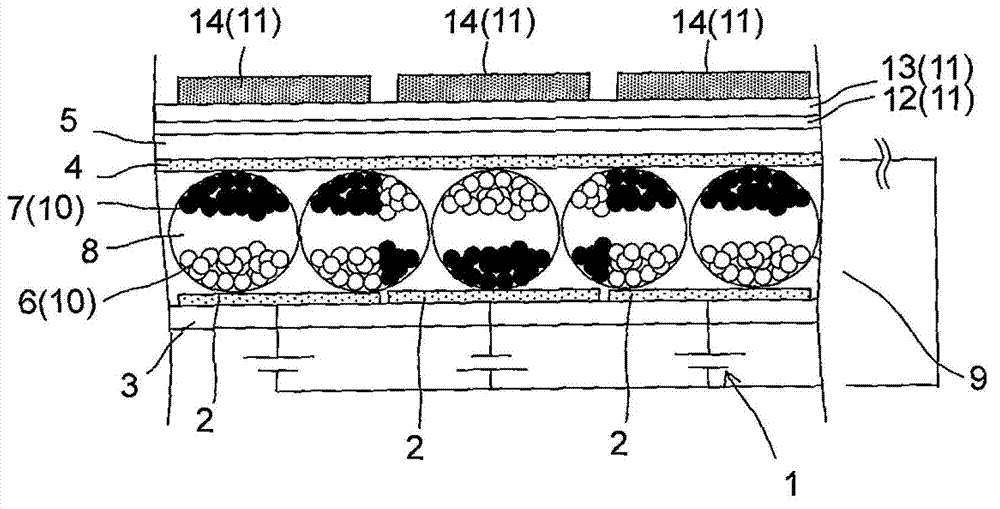Ultraviolet curable ink receptive layer for color filter, and method of producing color filter
A technology for an ink-receiving layer and a manufacturing method, which is applied in the directions of replication/marking methods, inks, nonlinear optics, etc., can solve problems such as inability to display black, poor contrast, panel damage, etc.
- Summary
- Abstract
- Description
- Claims
- Application Information
AI Technical Summary
Problems solved by technology
Method used
Image
Examples
Embodiment
[0102] [Preparation of colored inkjet ink (R1: red, G1: green, B1: blue)]
[0103] As shown in Table 1, firstly, diethylene glycol monoethyl ether acetate was dispersed in a bead mill as a solvent in the presence of a polymer dispersant using fine pigments for color filters to prepare red, green and Blue dispersion. Based on this dispersion liquid, the compositions shown in Table 1 were mixed, and the mixed solution was filtered through a 1 μm microfilter under pressure to prepare colored inkjet inks of various colors (colored inks). Table 1 shows the conjugate property values.
[0104] Table 1
[0105] Pigment ink composition
R1
G1
B1
PE-4A (liquid resin)
28.4 copies
29.1 copies
26.9 copies
EGDAC
60.4 copies
60.5 copies
60.4 copies
KBM-5103
0.6 copies
O. 6 servings
O. 6 servings
Irgcure907
3.9 copies
3.9 copies
3.7 copies
BYK-378
O. 1 copy
O. 1 copy
O. 1 ...
Synthetic example 1
[0138] 54.5g (0.384mol) of isobutyl methacrylate (iBMA), 76.8g (0.768mol) of methyl methacrylate (MMA), 2, 2'-Azobis[2-methyl-butyronitrile) (AIBN) 1.0g (0.006mol) and PGMEA (propylene glycol monomethyl ether acetate) 200g, at 80~85℃, under nitrogen atmosphere,
[0139] Stir for 8 hr to polymerize. After cooling to room temperature, PGMEA was added so that the solid content could be adjusted to 30%, and resin solution 1 was obtained. The resin P1 contained in the obtained resin solution 1 could not be measured at Mw=65000 and an acid value of 1 or less. The glass transition temperature is 45-50°C.
Synthetic example 2
[0141] 33.0g (0.384mol) of methacrylic acid (MAA), 6.15g (0.0433mol) of isobutyl methacrylate (MPA) and 2.21g of AIBN ( 0.012mol) and PGMEA80g, at 80-85°C under nitrogen atmosphere, stir for 8hr to polymerize. Furthermore, 48.8 g (0.384 mol) of glycidyl methacrylate (MGA), 1.44 g (0.0055 mol) of triphenylphosphine, 0.055 g of 2,6-di-tert-butyl-cresol, and 83 g of PGMEA were placed in the flask, It stirred at 80-85 degreeC for 16 hr, and obtained the (meth)acrylate resin containing a polymerizable double bond. According to the IR measurement of the obtained polymerizable double bond-containing (meth)acrylate resin, at 1409cm -1 (vinyl), 1186cm -1 (Carboxyl) peak was observed. From this, it was confirmed that it was a (meth)acrylate resin containing a polymerizable double bond. Further, it was diluted with PGMEA to adjust the resin solution 2 with a solid content concentration of 30%. The average molecular weight Mw=19000 of the resin P2 contained in the obtained resin solu...
PUM
| Property | Measurement | Unit |
|---|---|---|
| Film thickness | aaaaa | aaaaa |
| Glass transition temperature | aaaaa | aaaaa |
| Glass transition temperature | aaaaa | aaaaa |
Abstract
Description
Claims
Application Information
 Login to View More
Login to View More - R&D
- Intellectual Property
- Life Sciences
- Materials
- Tech Scout
- Unparalleled Data Quality
- Higher Quality Content
- 60% Fewer Hallucinations
Browse by: Latest US Patents, China's latest patents, Technical Efficacy Thesaurus, Application Domain, Technology Topic, Popular Technical Reports.
© 2025 PatSnap. All rights reserved.Legal|Privacy policy|Modern Slavery Act Transparency Statement|Sitemap|About US| Contact US: help@patsnap.com



